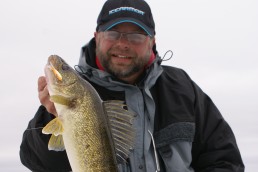Adjusting to Midwinter Doldrums
SHARE THIS POST
By midwinter, the ice is generally thick enough that you can drive your truck on it. So, you’re finally able to get to some of those deep-water honey holes where the fish stack up. But like all rules of thumb, there are exceptions. Sometimes, you want to move shallower, even during the midwinter doldrums when fishing seems to slow in deep-water places where you have consistently been on fish. The key is recognizing some of the factors that cause fish to move into shallower water and reacting to them in a timely manner. It can be the difference between a skunking (or, at least, a very slow bite) and a sack full of fish.
This general principal applies to most species we pursue, for a simple reason: Most freshwater gamefish (except the salmonid/char species like salmon, lake trout, brook trout, or even whitefish) spawn in spring. When they perceive the proper stimulation, they begin to move to where they’re going to do their duty to the future. It’s true for almost all warm-water finsters—bluegills and other sunfish, crappies, perch, pike and of course, my personal favorites, walleyes. (And for bass, too, but very few people fish through the ice for bass because, in most places, the season is closed during the winter months.)
The two main triggers causing fish to move are warm weather and rain. In either case, it’s because of increased runoff, either from melting snow and ice or from the rain itself. The increased movement of water stimulates the fish to get going. Think about it: Rain or significant melt-off causes steelhead, which are spring spawners, to head upstream to the gravelly stretches where they reproduce. Well, the same principal applies to walleyes. Increased flow stimulates them to seek out the areas where they are going to spawn.
And where is that? Walleyes typically spawn in rivers or on reefs, both of which are shallower than their deep-water haunts in the dead of winter. So, anywhere a river or creek enters a lake is a good place for anglers to head toward because that’s where the walleyes are headed. Keep in mind that the key word here is shallower. Not necessarily shallow, but shallower. The fish in the middle of a large lake aren’t necessarily going to swim to the banks, but they will head to the rock and gravel bars that are shallower than the holes or deep flats where they’ve been congregating.
These events do not signal a complete change in habit. When the cold weather snaps again, the fish move back to deep water. Almost immediately. If you’re out deep and you’re not catching them, don’t just wait them out because you may be waiting forever. You can’t catch fish that aren’t there.
You’ve heard of the term “February thaw,” right? This typically takes place in February, although it can be as early as late January and, during brutally cold winters, it might not happen until March. But be prepared to change your game plan quickly if you want to keep catching them.
Are you enjoying this post?
You can be among the first to get the latest info on where to go, what to use and how to use it!
Keep in mind, as well, that these are false spawning runs. The fish are not spawning, so they’re still eating. So that calls for a more aggressive presentation, as you’re getting after fish that are stimulated for feeding action. So, I like aggressive baits; Jigging Raps, Snap Raps and Slab Raps all fit the bill, as do spoons. I especially like Tingler spoons, but there are plenty of options.
But you must fish them aggressively. Instead of inching that bait up slowly to stimulate the bite, bring it! In clear water, you can even see the prey species of minnows or small fish (like gobies) swimming around among the rocks and gravel. The fish are in tune; they’ll see that motion and come flying in with their mouths open. Keep the bait moving. Bring that lure all the way up to the surface and keep it coming until you can’t anymore, then drop it back down and do it again. Don’t bring it up an inch at a time; reel fast to stimulate their predatory instincts.
When you’re moving shallower, make sure you check the ice. Shallow water ice thins out more quickly; you’ll notice that along the shoreline, there’s open water on the bank—so use a spud to check the ice. You should always have a spud—it’s a multi-faceted tool. You can use it for a variety of tasks, such as an anchor to winch a snow machine out of slush hole or crack in the ice.
And this is a good time to wear a float suit in case you run into thin ice.
Get better results from the time you spend fishing. Use information from the pros found in every issue of MidWest Outdoors, available by subscribing on our website.
MWO
SHARE THIS POST
You may also like...
Nothing found.
Did you enjoy this post?
You can be among the first to get the latest info on where to go, what to use and how to use it!
Mark Martin
Mark Martin is a professional walleye tournament angler and instructor with the Ice Fishing School/Vacation series. For more information, check out his website at markmartins.net or fishingvacationschool.com.
